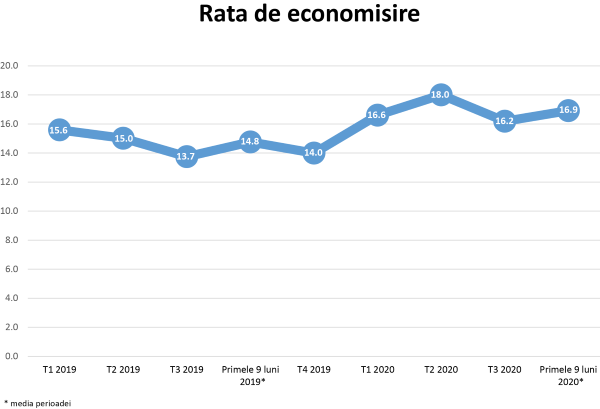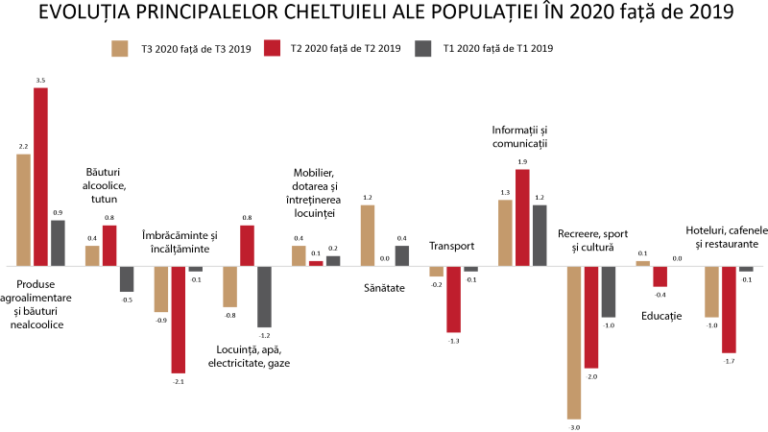 The pandemic has significantly changed the consumption habits but also the saving habits of Romanians, according to the INS data analysed by cursdeguvernare.ro.
The pandemic has significantly changed the consumption habits but also the saving habits of Romanians, according to the INS data analysed by cursdeguvernare.ro.
The saving rate registered a record increase in 2020 and the average of the first nine months was 16.9%, compared to 14.8% in the same period in 2019.
After reaching 18% in the second quarter, it stabilized at 16.2% in the autumn, slightly below the Eurozone average of 17.3% over the same period.
However, the data are not 100% comparable because Eurostat uses a slightly different methodology from the one used in this analysis, which was based on INS data, collected in a different manner.
Saving rate:
 Although the gap between the average saving rate in Western EU countries and the one at the local level started to fade even in 2019, Romanians’ much more limited capacity to save was strongly showed in the second quarter of 2020. Then, the average of citizens’ savings in Europe’s developed countries reached almost 25%, by 6.6 percentage points above the average savings in Romania.
Although the gap between the average saving rate in Western EU countries and the one at the local level started to fade even in 2019, Romanians’ much more limited capacity to save was strongly showed in the second quarter of 2020. Then, the average of citizens’ savings in Europe’s developed countries reached almost 25%, by 6.6 percentage points above the average savings in Romania.
The difference decreased to 1.1 percentage points in the third quarter, as the European consumption woke up.
Positive results for food products, negative for clothes and recreation activities
Romanians’ savings in 2020 resulted mainly from the decrease in spending on activities restricted in the context of the health crisis: travel, recreation, restaurants, but also clothing or transportation (a consequence of teleworking). On the other hand, the pandemic also led to an increase in the share of spending on food, alcohol and tobacco, furniture, health and IT&C equipment.
*
- Evolution of main categories of population’s expenses in 2020, compared to 2019
- Q3 2020 compared to Q3 2019 Q2 2020 compared to Q2 2019 Q1 2020 compared to Q1 2019
- Agri-food products Alcoholic beverages, tobacco Clothing and footwear House, water, electricity and gas Furniture, home endowment and maintenance Health Transport IT&C Recreation, sports and culture Education Hotels, coffee shops and restaurants
*
As a share of total consumer spending, categories such as clothing and footwear, transport, recreation, sports and culture and hotels, coffee shops and restaurants declined during the first nine months of 2020.
On the other hand, food expenditure registered the largest increase, with a peak of 37.7% in the share of consumer spending in the second quarter of the last year. IT&C expenditures also had significant shares, of 5.9% in Q3 2020 compared to 4.7% at the beginning of 2019.
The structure of other types of expenditures, such as investments, does not seem to have been significantly affected by the pandemic, as decreases were marginal compared to 2019. As a percentage, this was at the level of the third quarter of last year, at 0.7% of household expenditures, or the equivalent of 32.7 RON per month.
In the short term, economists expect the saving rate to remain high, amid the persistent pandemic.
Andrei Radulescu, director of Macroeconomic Analysis at Banca Transilvania, foresees a decrease, once the confidence indicators will improve.
„In our scenario, population’s annual average saving rate could decrease to levels of 15% in Romania, 13.8% in the Eurozone and 9.3% in the US in 2021,” wrote Andrei Radulescu, in a note sent to investors.










